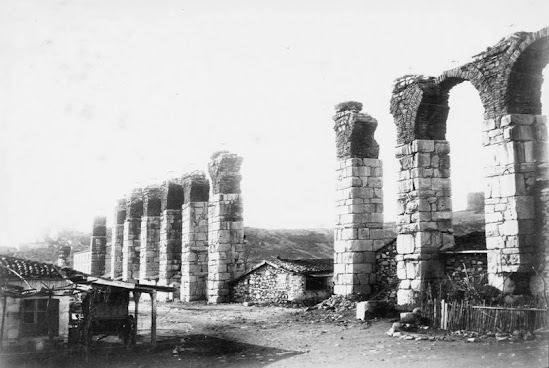Mark Twain Visits Ephesus
From The Innocents Abroad:
“This
has been a stirring day. The Superintendent of the railway put a train at our
disposal, and did us the further kindness of accompanying us to Ephesus and
giving to us his watchful care.
“At ancient Ayassalook, in the midst of a forbidding desert, we came upon long lines of ruined aqueducts, and other remnants of architectural grandeur, that told us plainly enough we were nearing what had been a metropolis, once.”
In 1867,
the year Twan visited Ephesus, there was a railway station in Selcuk (then
called Ayasoluk), but not much else. The railway connected various farming
communities with the port city of Izmir. Twain was one in a group of tourists en
route to the Holy Land. Nowadays, most of the tourists visiting Ephesus travel
by bus from monstrous cruise ships that dock in Kusadasi. The few who stay in the
boutique hotels of Selcuk get there by taxi, or, if they’re fit, they walk.
There were no taxis in Twain’s day, and it was too hot to walk. He and his
companions were provided with donkeys.
“The little donkeys had
saddles upon them which were made very high in order that the rider’s feet
might not drag the ground. The preventative did not work well in the cases of
our tallest pilgrims, however. There were no bridles—nothing but a single rope,
tied to the bit. It was purely ornamental, for the donkey cared nothing for it.
“If he were drifting to starboard, you might put your helm down hard the other way, if it were any satisfaction to you to do it, but he would continue to drift to starboard all the same. There was only one process which could be depended on, and it was to get down and lift his rear around until his head pointed in the right direction, or take him under your arm and carry him…”
“We all
stood in the vast theatre of ancient Ephesus,—the stone-benched amphitheatre I
mean—and had our picture taken. We looked as proper there as we would look any
where, I suppose. We do not embellish the general desolation of a desert much.
We add what dignity we can to a stately ruin with our green umbrellas and
jackasses, but it is little. However, we mean well.
“I wish
to say a brief word of the aspect of Ephesus.
“On a
high, steep hill, toward the sea, is a gray ruin of ponderous blocks of marble,
wherein, tradition says, St. Paul was imprisoned eighteen centuries ago. From these
old walls you have the finest view of the desolate scene where once stood
Ephesus, the proudest city of ancient times, and whose Temple of Diana was so
noble in design, and so exquisite of workmanship, that it ranked high in the
list of the Seven Wonders of the World.”
The
stone structure on a hill overlooking the ruins is still called “St. Paul’s
Prison,” but it probably isn’t. There’s no evidence that Paul was imprisoned in
Ephesus, and no evidence, if he were, that he was imprisoned in that particular
building. It’s actually a guard house built into the fortified wall around the
city, built, probably, during the reign of Lysimachus in the 3rd
century BCE. Tour guides prefer the prison story.
Twain
continued:
“Behind
you is the sea; in front is a level green valley, (a marsh, in fact,) extending
far away among the mountains; to the right of the front view is the old citadel
of Ayassalook, on a high hill … Further toward you is the hill of Pion [Mt.
Panayir], around whose front is clustered all that remains of the ruins of
Ephesus that still stand; divided from it by a narrow valley is the long,
rocky, rugged mountain of Coressus. The scene is a pretty one, and yet
desolate—for in that wide plain no man can live, and in it is no human
habitation. But for the crumbling arches and monstrous piers and broken walls
that rise from the foot of the hill of Pion, one could not believe that in this
place once stood a city whose renown is older than tradition itself.”
That was
then. This is now, no longer desolate, no longer uninhabited.

Photo Taken from the Old Citadel


Comments
Post a Comment